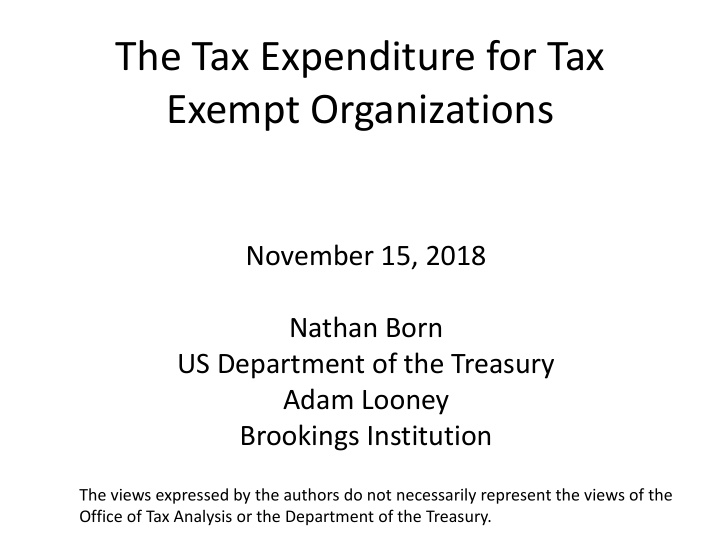



The Tax Expenditure for Tax Exempt Organizations November 15, 2018 Nathan Born US Department of the Treasury Adam Looney Brookings Institution The views expressed by the authors do not necessarily represent the views of the Office of Tax Analysis or the Department of the Treasury.
Tax Exemption and Tax Expenditures • Tax Expenditures are large indirect subsidies – Exclusions of income, deductions, special treatment etc. • Tax exempt status under 501(c) provides preferential exclusion in tax law • Value not currently published by OTA or JCT • Value of exclusion is unclear
Research Question • What is the value of tax exempt status? • Which organizations benefit the most from tax exempt status and why? • We quantify the cost of the exclusion of positive net income of tax exempt organizations • Not a proposal to include exclusion as a tax expenditure
Overview • Estimation of the tax expenditure for tax exempt organizations – Income exclusion – Charitable deduction • Conceptual issues and ongoing research
Methodology – Exclusion of Income • Income = Form 990 Microdata Positive Net Income less: – Unrelated Business Income – Carryforward/carryback net operating losses • Tax Expenditure = Max {Taxable Income * Graduated Corporate Rate, 0}
Illustrative Example • Hospital X Income = 1,000,000 – Expenses = 750,000 – Unrelated Business Income = 20,000 – Imputed NOLs Carried Over = 10,000 ________________________ Imputed Taxable Income = 220,000 Imputed Tax liability = approx. 77,000
Methodology – Individual Deductions • Deductions claimed on Form 1040 – Cash, non-cash, carryover deductions – Short/long term gains on donations of financial assets using cost basis and market value data from Form 8283 • Treasury’s Individual Tax Model used to calculate value from Individual Donations
Illustrative Example Charitable Deduction Current Law Without Tax Subsidies Deductions of cash contributions 500 0 Deductions of non-cash contributions 200 0 Charitable Deduction 700 0 For Donations of Appreciated Assets Market Value 200 200 Basis 150 150 Capital Gains (Schedule D) 0 50
Tax Expenditure for the Tax Exempt Sector Billions USD, 2013
Largest Tax Expenditures Billions USD, 2013
Tax Expenditure: Exclusion of Net Income USD Billions, 2013 Constant Dollars Income/Expenses No Gifts
Charity Type: Tax Expenditure for Exclusion Billions USD, 2013 Rev. Source
Tax Expenditure for Individual Deductions Billions USD, 2013
Tax Expenditure for Non-Cash Contributions by Type of Donation Billions USD, 2013 Subsidy as % of Donation Type Donations Tax Expenditure Donation Stock $19.7 $6.9 35% Mutual Funds $1.6 $0.6 38% Other Financial $2.2 $0.9 40% Land and Real Estate $2.0 $0.7 34% Easements $1.1 $0.3 27% Art/Collectibles $1.2 $0.3 22% Clothing $9.7 $2.1 22% Household $4.2 $0.9 22% Under $500 $5.2 $1.0 20% All Non-Cash Donations $52.0 $9.1 17%
Conclusion • Tax Expenditure for Exclusion of net income from the tax base may be associated with a high cost ($56B) • Tax Expenditure for tax exempt organization benefits hospitals ($15B) and education institutions ($12B) • The Exclusion of Capital Gains donations is a substantial subsidy to donations of financial assets and land/real estate
Conceptual Issues and Ongoing Research • Treatment of gifts to charitable organizations • Charitable and tax exempt organizations would likely alter behavior in the event of being subject to taxation – Further research on behavior of tax exempts which switch to F1120 could offer insights on changes in behavior
Thanks for listening!
Total Expenses and Revenue for Charitable and Other Tax Exempt Orgs USD Billions, 2013 Constant Dollars Rev Sources Return
Methodology
Tax Exempt Orgs: Sources of Revenue, 2013 Return
By Charity: Sources of Revenue, 2013 Return
Imputed Tax Liability, Excluding Net Gift Income USD Billions, 2013 Constant Dollars Return
Revenue and Expenses for Exempt Organizations USD Billions, 2013 Constant Dollars
Recommend
More recommend